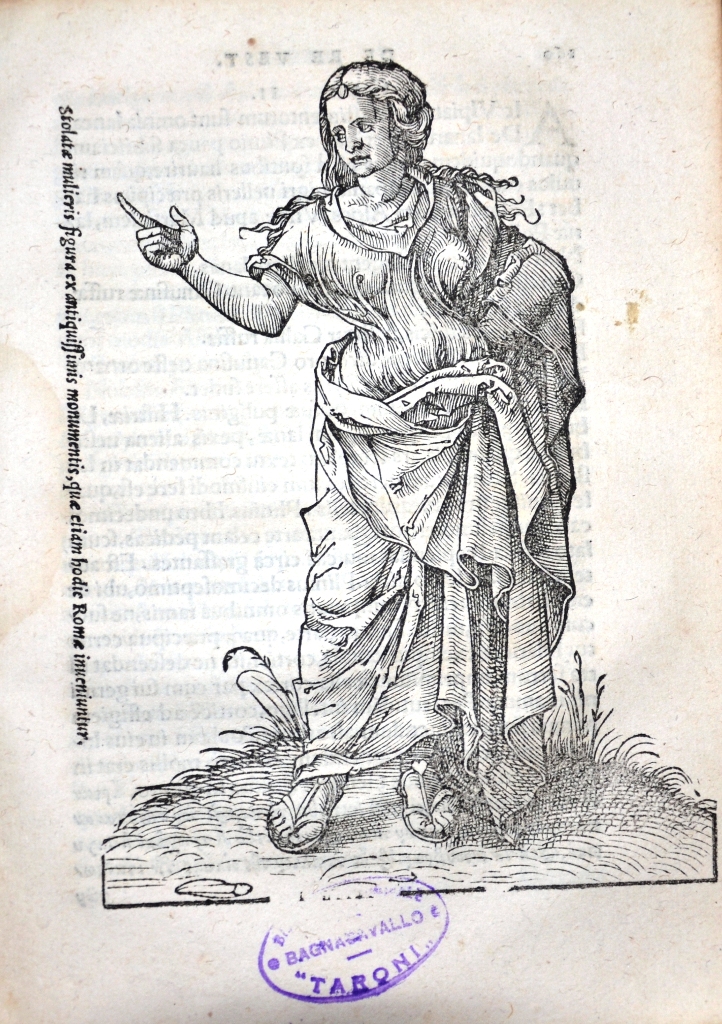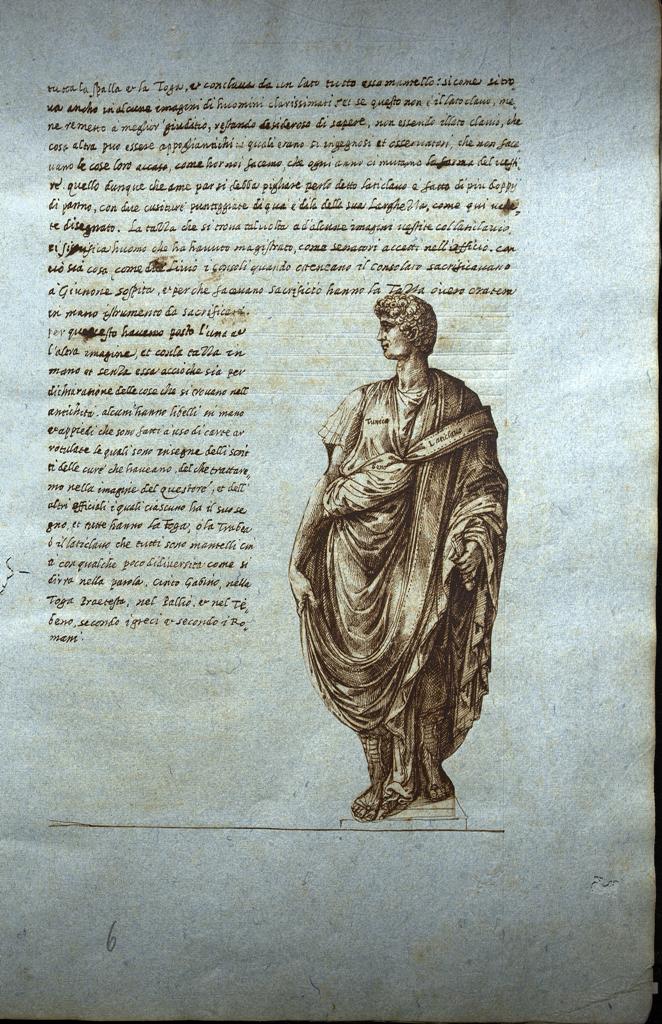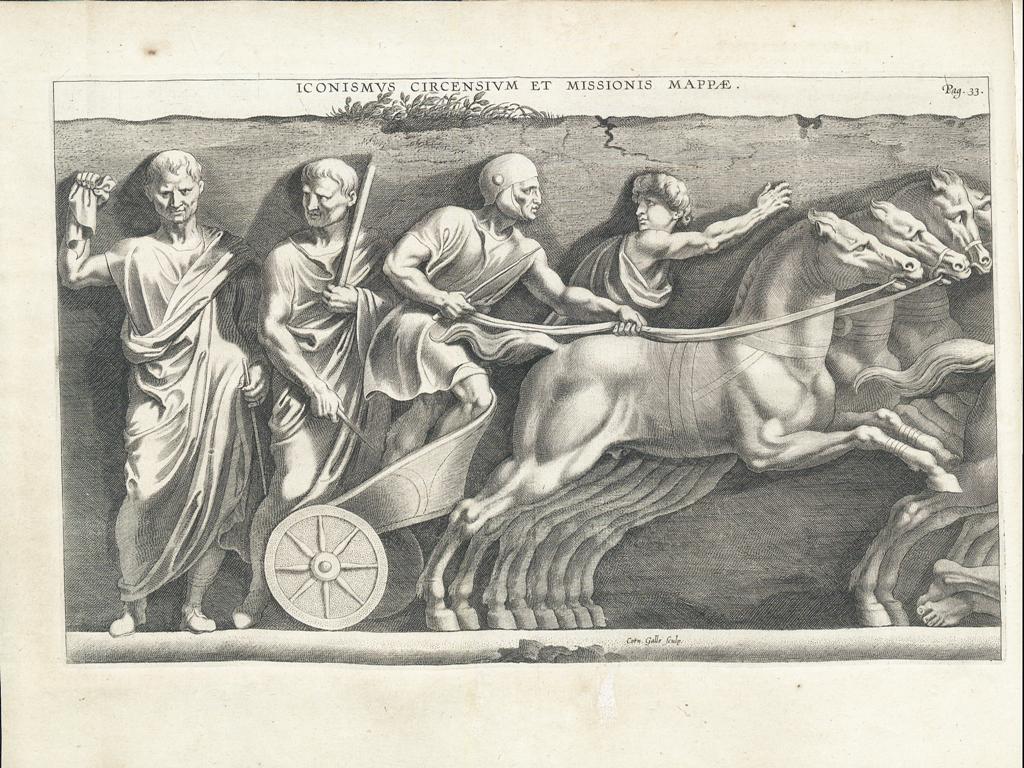Vestis virum facit.
εἴματα ἀνὴρ, id est, vestis vir.
(Erasmus 1528, III, 60)
1. Introduction
In the entry for toga found in The Classical Tradition, Caroline Vout argues that the interest in ancient clothing in early modern times emerged during the seventeenth century in the works of the Italian and Flemish scholars Ottavio Ferrari and Albert Rubens, both of whom arrived at a clearer understanding of ancient Roman and Greek garments (Vout 2010, 937-8; Vout 1996, 204-220). She also contends that their works were prefigured by Cesare Vecellio, a cousin of the painter Titian, who at the end of the sixteenth century published one of the most extensive treatises ever compiled on ancient and modern clothing from all over the world. This view, even if partially correct and reasonably credible, fails to take into account the wider aspects of the question: in fact, attention to this matter first began to materialise approximately one hundred and fifty years earlier, and the two aforementioned humanists were only the most recent expressions of a much more complex and stratified cultural tradition.
During the Renaissance many catalogues of clothes and fashion were published throughout whole Europe (Nevinson 1952; Tuffal 1952; Blanc 1995; Butazzi 1995; Guérin Dalle Mese 1998, 12-17; Jones, Stallybrass, 2000; Davanzo Poli 2001, 65-66; Davanzo Poli 2004; Rosenthal, Jones 2010, 15-20; Reolon 2013, 60). However, this interest in ancient garments, which stemmed from the wider spectrum of antiquarian erudition, can be dated to a precise timeframe when some of the most important scholars and artists of the period produced significant treatises that gave rise to the rich genre de re vestiaria. Works focusing specifically on clothing began to appear in the mid-fifteenth century and blossomed during the decades that followed, reaching their zenith in the mid-seventeenth century. During this time, a gradual evolution in the construction of various contents occurred alongside advancements made in archaeological and philological investigative methods.
The early modern scholars who studied ancient clothing approached the question from two different starting points: the first was a focus on literary sources, which involved identifying any written references to a specific garment from which its form or function could be understood; the second was a focus on material sources, which were composed mainly of ancient archaeological findings such as statues, bas-reliefs, gems, cameos, fresco paintings, and coins, all of which often featured clothed figures. By merging these two areas of research, they were able to assign names to the garments mentioned or represented and give them shape according to their written description or appearance on an artefact. As could be expected, the rapid change in customs caused the names or functions of many garments to also change over time. The often unclear representations in ancient findings did not help in this regard. Initially, significant difficulties were encountered even when simply attempting to identify a toga, trabea or tunica or imagine what they looked like.
The purpose of this contribution is to retrace the history of the treatises on ancient clothing written during the Renaissance, to identify as many works as possible and describe their different approaches so as to include them in the broader context of the history of ideas. Two case studies will also be presented in order to demonstrate the influence this knowledge had on the cultural life of the time: the first illustrates its impact on ancient theatrical costumes, specifically in Rome and Vicenza at the beginning and end of the sixteenth century; the second focuses on the pictorial decorations of the Gallery of Francis I at Fontainebleau between 1534 and 1538. These investigations, which attempt to describe the vitality of the overall phenomenon, represent just two samples of a plurality of options from which new studies and analyses on the topic may emerge in the future.
2. Renaissance works de re vestiaria
Towards the end of the fifteenth century, Angelo Poliziano attempted to embrace the sum of human thought conceived by the ancients. In his Panepistemon, one of his most important academic lectures, he tried to classify clothing into a specific group referred to as αποχειροβίωτοι, that is to say, those who work with learned hands or, in other words, the artisans (illi quales fabri sunt omnes) (Poliziano 1491, 19-23). Here, he listed a series of professions (35 in all) related either directly or indirectly to clothing, including those who worked the raw materials (lanarios, sericarios), those who tailored the garments (textatores, sarcinatores), those who were responsible for dying the cloth (violatores, molochinarios), and many others (Poliziano 1491, 23). Since clothing was gradually becoming an area worthy of research in its own right, with specific characteristics that required separate handling and the use of specialised methodological instruments, this sequence served as the basis for all subsequent works on the topic. Poliziano did not spark a real discussion on clothes in the ancient world, but instead introduced specific categories within which these aspects of cultural heritage could be classified for further investigation.
This structure seems to appear ante litteram in the first discussion on this subject, the mid-fifteenth century treatise Roma triumphans composed by Flavio Biondo. Biondo dedicated just a few pages to ancient Roman clothing – book IX in a section titled De vestibus (Biondo 1559, 194-9). His study began with the fabrics used, moved on to the occasions for which the clothes were worn and then identified the different styles based on gender distinctions (virilia, muliebrilia), chromatic variations (vestium colores) and other characteristics such as the origin of some garments (vestium origo). All these aspects, however, were dealt with very rapidly.
A few decades later, in 1499, Polydor Vergil, an Italian scholar based in Britain, published his De rerum inventoribus in which he sought to reconstruct the real or mythical origins of ancient art and knowledge. Among the many aspects he discussed, he also included a section on clothes (III, VI). Polydor adopted a holistic approach similar to that of his predecessors. His investigation started with the raw materials (qui primus invenit linum) and then went on to examine the art of weaving, the art of fabric dyeing, and the soap used to wash clothes (Virgili 1499, 242-253). Polidoro was the first to define the art of weaving as a cultural development that replaced the previous practise of wearing animal hides.
A similar point of view was adopted by Raffaele Maffei in his Commentariorum rerum urbanarum libri, published in 1506. Maffei discusses clothing in the third book of his work, which deals with philology and the basic principles of the arts (Tertius tomus philologiam continet, id est, variarum artium rudimenta). In particular, he includes a section entitled De vestibus omnis generis et sexus (Maffei 1506, 659-664). Here the names of the ancient garments are all listed mostly without an explanation and with only a literary source provided as a reference. Preceding this series of words there is a description of various fabrics that is in line with the usual scheme adopted in previous treatises. Maffei concludes with a list of the costumes used for ancient tragedies, comedies, and satires (De calciamentis ac tunicis, et vestibus tragicis, comicis ac satyricis).
1 | Lazare de Baïf, De re vestiaria, Basel, Froben, 1537, p. 15.
Even the Antiquae Lectiones published by Ludovico Ricchieri in 1516 and the Geniales dies published by Alessandro Alessandri in 1522 dedicate some pages to ancient clothing. In chapter X of book IX, titled Vestimenta genera plura, Ricchieri lists a series of clothes mentioned by classical authors and proposes an etymology and explanation for their specific use (Ricchieri 1516, 430-434). Alessandri, instead, adopts a slightly different approach: in chapter XVIII of book V, in which he discusses the social disparities in Ancient Rome, with particular focus on the distinctions between patricians and plebeians, there is a section titled Discrimen in vestibus apud diversas gentes which includes a detailed list of the various clothes worn by the Ancient Romans and those inhabiting their subjugated provinces (Alessandri 1522, 284-292).
In spite of these scholars’ writings, ancient clothing became widely known in Renaissance erudite studies only in 1526 when Lazare de Baïf, a French antiquarian and ambassador to Venice and Germany, published his De re vestiaria. This work (Baïf 1526), which represents the first monographic treatise on the matter, met with immediate favour and was quickly reprinted by the most prestigious editors in Europe (the first complete with images was issued by Froben in Basel in 1537) [Figs. 1, 2]. This work eventually became the benchmark for all the treatises on the subject that followed. Even Erasmus of Rotterdam paid extensive attention to this work (Baïf 1530), as is evident from some of his letters and the reference he made to the French scholar in his Adagia (De la Garanderie 1985, 87-88). Baïf continued to adhere to the ordinary paradigms previously applied to this subject, but was able to extend each topic and build a complex and more reliable argument from both a philological and an archaeological perspective. His considerations sprung from the explanation of book XXXVIII of the Pandects written by Ulpian, which discussed some restrictive provisions in Roman law regarding clothing. Baïf divides the subject into 21 untitled chapters that deal with the vocabulary of ancient clothing, fabrics, the different types of male and female clothing, and questions about their functions, headdresses, and footwear. The most significant improvement on all previous works was Baïf’s cross-examination of various literary sources, both Latin and Greek and from different periods, which at times he matched with ancient findings. This broadening of references allowed him to construct a completely new treatise within the framework of the sixteenth-century editorial scene.
2 | Lazare de Baïf, De re vestiaria, Basel, Froben, 1537, p. 19.
The success of this work can also be measured by the revisions and additions made by other authors in new editions of the work, especially the one compiled by the French antiquarian, botanist and physician, Charles Estienne (Estienne 1535a; Armstrong 1954), a member of the family of printers and a pupil of Baïf himself, who published his De re vestiaria libellus, ex Bayfio excerptus in 1535. Estienne produced an original and particularly interesting version of Baïf’s work by taking the original and restructuring it so as to make it easier to read: he reordered the text into ten different interpretative categories based on parts of the human body, something that until then had never been done for this subject. He structured his treatise to run from the top of the body to the bottom, i.e. from hats and headdresses to shoes and footwear, and provided the French equivalent for all the Latin and Greek terms for fabrics and clothing, again in order to make it easier to read especially for young students (in adulescentorum gratiam atque utilitatem). Moreover, he enriched the treatise by adding, in square brackets, details omitted by Baïf, thereby broadening its interpretative perspectives.
After the publication of Baïf’s De re vestiaria, all subsequent treatises on ancient clothing fell under its influence, either adhering to or deviating from it. For example, when the Austrian scholar Wolfgang Lazius published Commentaria Reipublicae Romanae illius, in exteris provinciis in 1551, an important dissertation on the structure of the Roman state in provinces outside of Italy, he dedicated the whole of book VIII to Roman civil and military clothing (De vestimentis) (Lazius 1551, 826-90). His discussions amounted to nineteen chapters that subdivided Roman clothing into the following categories: daily life; peace and war; religious functions; and other, which in turn were embraced other social categories, such as patricians and plebeians, or politicians, as senators and equites. A discussion on each specific garment then followed (toga, trabea, praetexta), thereby adhering more directly to Baïf’s model.
3 | Pirro Ligorio, Libro VIII dell’Antichità, 1550 ca., f. 6.
In his Discours sur la religion des Romains (1556) Guillaume du Choul limits his discussions to a monographic investigation of ancient religious clothing, drawing attention to the different types of priest and minister (flamines, augures, pontifices, vestales) and linking different sources and ancient objects to his discourse (Du Choul 1556, 260-261). He also includes images taken from numismatic and archaeological findings, thereby offering a visual counterpart to the theory presented.
Another particularly relevant case is the treatise of Pirro Ligorio on clothing in the ancient world. His Di alcune varietà di vestimenti di re e di magistrati romani, di privati e dell’altre usanze di diversi popoli, is included in his antiquarian encyclopaedia, Libri di Antichità (National Library of Naples ms. XIII B 3), which remained in manuscript form. The work is normally dated to before 1561 (DBI 2005, 65). In several chapters, Ligorio uses Italian vernacular to retrace a series of features of Roman clothing, taking literary sources and various archaeological findings into account. The manuscript is autograph and illustrated by Ligorio himself, at times with very detailed drawings, and at other times with only rough sketches [Fig. 3]. When observing the layout of the text on the page, it is clear from the abundance of empty spaces that Ligorio’s intention was to augment the work with further illustrations.
A different approach was adopted by Alessandro Sardi from Ferrara in his De moribus et ritibus gentium of 1557: in chapter XIX of book I, he focused on the issue of clothing from a geographical perspective, describing the attire of various populations: Asian, European, African, Barbarian and, to conclude, Greek and Roman (Sardi 1557, 37-43). This was the first time this subject matter had been classified according to this criterion, pace Alessandro Alessandri whose study on the clothing of populations conquered by the Romans could be seen as a precursor. What emerges in Sardi’s work is not only this author’s originality and innovation, but also an increase in the amount of investigative material available after the mid-sixteenth century.
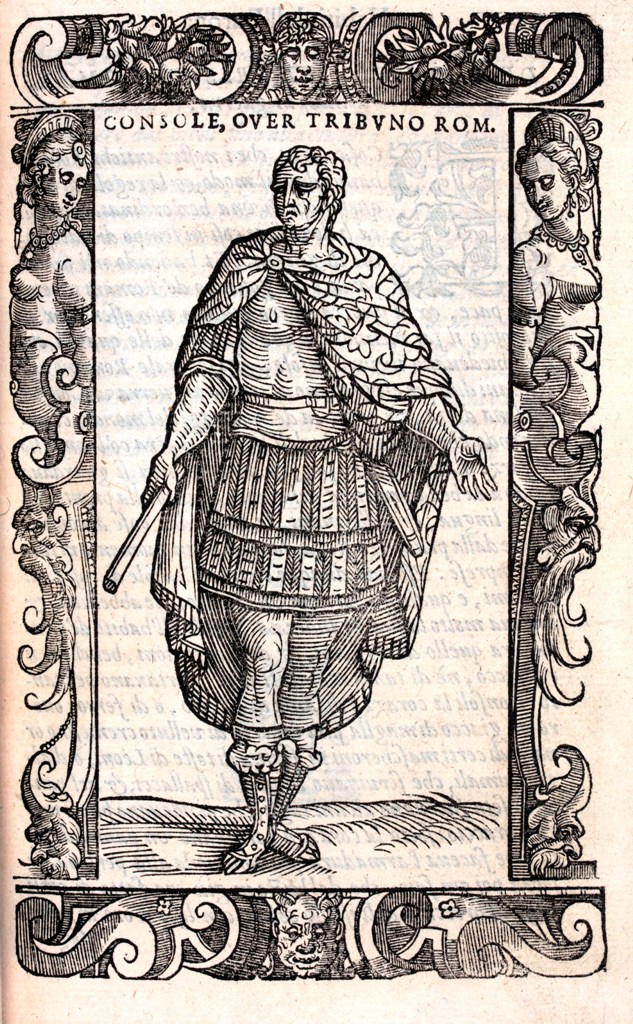
4 | Cesare Vecellio, Delli habiti degli antichi, 1590, p. 16.
In 1576, it was the turn of Aldo Manuzio the Younger, son of Paolo and nephew of Aldo the Elder, to contribute to the discussion on ancient clothing. In a miscellaneous collection, De quaesitis per espistolam libri III, he dedicated three lengthy chapters to Roman clothing (De toga Romanorum, De trabea, De tunica Romana), which together form a monograph within the macro-structure of his work (Manuzio 1576). There are reasons to believe that part, if not all, of this material was taken from the unpublished papers of his father, Paolo Manuzio, who died in 1571. Evidence for this can be found in an epistolary exchange between Paolo and Fulvio Orsini in 1567, where Paolo requested Orsini’s opinion on a chapter dedicated to the Trabea (Nolhac 1883, 284-6). From this, it is possible to infer that Paolo, whose papers were used by his son Aldo to arrange his own work, spent those years preparing a treatise on ancient clothing that it had already been at an advanced stage. One should also note that the subject of ancient clothing had garnered significant interest in the erudite circle of Orsini and Manuzio that year, with even Onofrio Panvinio and Carlo Sigonio discussing the matter. It appears that Sigonio had sought to write a treatise, De re vestiaria, which was never actually completed, in response to Baïf’s treatise, which he considered unsatisfactory; for this reason, he asked Panvinio for some clarifications on the subject. Panvinio, who probably discussed this topic in his unpublished treatise Antiquitates Romanae (BAV Vat. Lat. 6783), responded by sending him some sketches of ancient clothes.
A few years later, the German scholar Johann Roszfeld focused on this issue, including an overview on Roman clothing titled De vestimentis in book X of his Romanarum antiquitatum libri, which was published in 1583. In that work, Roszfeld devoted six chapters (XXXI–XXXVI) to various considerations on Roman clothing in general and specific garments (the toga, tunica and trabea), including women’s clothing and footwear (Roszfeld 1583, 213-25).
A work on clothing that features a wide-ranging discussion on ancient clothing is Degli habiti antichi et moderni (1590), by the Italian painter Cesare Vecellio (Vecellio 1590; Reolon 2013). The purpose of this work was to gather an extensive compendium of all the clothes known in the history of civilisation. An anthropological consideration on the development of clothing throughout the centuries and according to the customs of various peoples opens this treatise, followed by the engravings and descriptions of each garment by geographical area (Europe, Asia, Africa) and by social level (noblemen, plebeians, artisans, priests). The work begins with a general overview of ancient clothing (chapters IV, IX, X, XII, XIII), where Vecellio discusses the various materials used, the Roman laws that limited the ownership of luxurious clothing, and the names of each garment (Vecellio 1590, 12-25). As a result, his work went on to become the largest figurative repertoire of ancient clothing available during the Renaissance [Fig. 4].
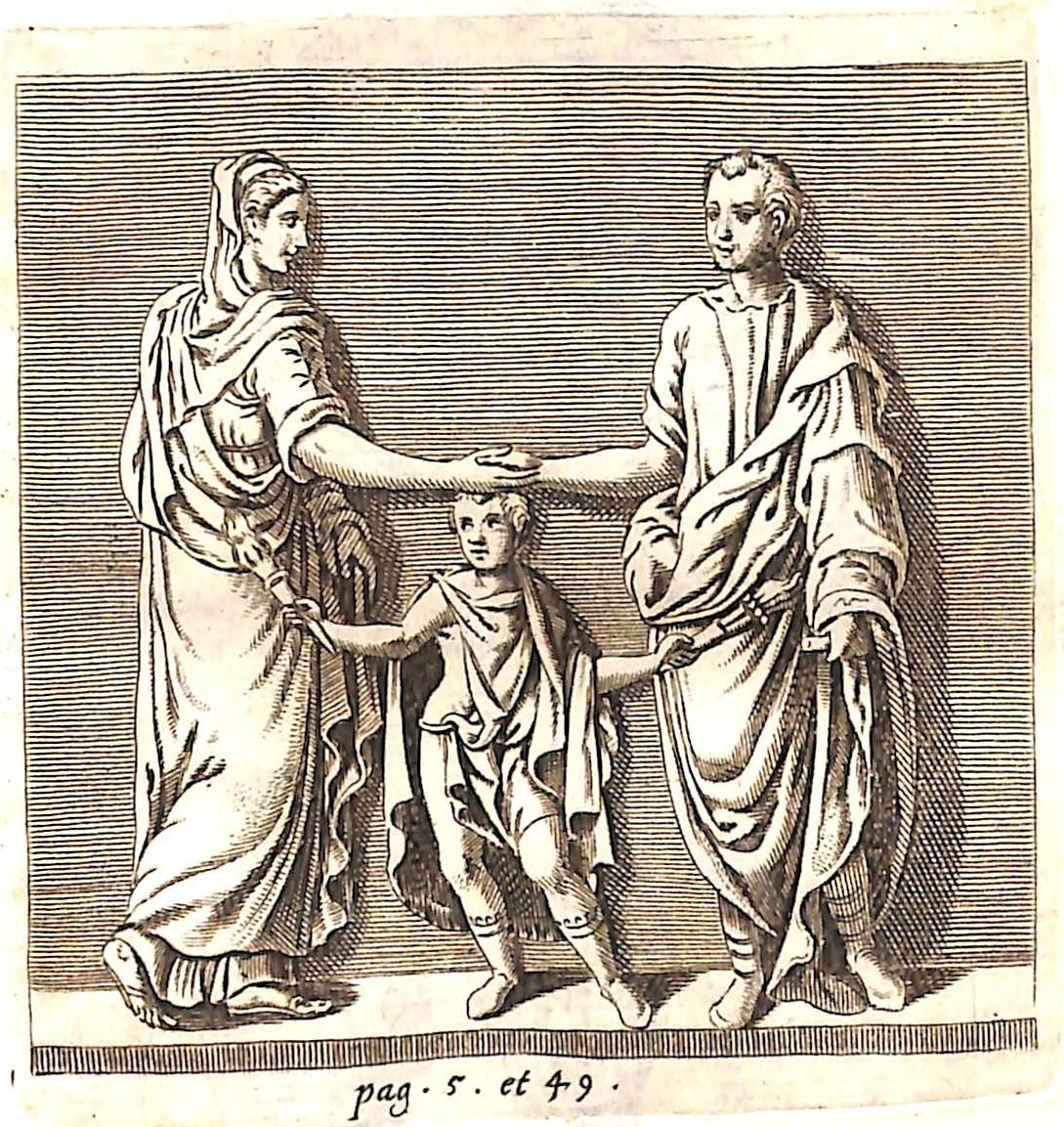
5 | Ottavio Ferrari, De re vestiaria, 1642, p. 5.
Fifty years would pass before another work on ancient clothing was written. Ottavio Ferrari, an academic at the University of Padua, published a treatise entitled De re vestiaria. The first edition of his work was printed in 1642 in the form of three books that described the toga, the praetexta and the tunica through a multiplicity of philological references (Ferrari 1642). The second edition, which comprised four additional books, each of which discussed De lacernis, De paenulis, De veste militari and De pallio, was published in 1654 (Ferrari 1654). This work is accompanied by a figurative apparatus [Fig. 5], which, although meagre, was effective at synthesising general iconographic sources (especially coins and statues).
Lastly, in 1665 Albert Rubens published his treatise De re vestiaria. This work is divided into two books, the first of which is dedicated to clothing and the second to accessories, from headdresses to footwear (Rubens 1665). The genesis of this treatise is clearly rooted in the humanistic culture of his family. In fact, it was inspired both by the experience of Peter Paul Rubens, the famous painter and the father of the author, and by the studies of Philip Rubens, antiquarian scholar at the time who was also Paul’s brother and Albert’s uncle (van der Meulen 1994, 69-128). It is well known that the education of Peter Paul Rubens as a cultured painter also included an antiquarian apprenticeship that involved imitating ancient models of every type, including clothing (van der Meulen 1994). Among the drawings completed by this great Flemish artist, many feature figures wearing ancient garments, which in part reappeared in his pictorial works. Peter Paul Rubens arranged the iconographic tables for his brother’s work [Fig. 6], a miscellany of antiquarian erudite works entitled Electorum libri duo (Rubens 1608), the purpose of which was to discuss a variety of controversial philological cases. Seven chapters were dedicated to clothing – especially the toga (I, 17), the flag at the circus (I, 30), clothes with images or inscriptions (II 1), military outfits (II, 2), women’s footwear (II, 14), the tunic (II, 20) and headdresses (II, 25). The most interesting aspect to note is that all the images in this collection refer exclusively to these chapters, which demonstrates a special convergence of the two brothers’ interests on this topic. In this framework, it can be seen how Albert Rubens took inspiration from his family experiences – several drawings by his father were in fact included in his work, and some of the philological readings of his uncle are referred to and discussed in his treatise (Sed optime patruus meus Philippus Rubenius l. I Elect. c. XVII per imagines interpretes nos docuit quid sinus esset) (Rubens 1665, 176). This demonstrates, almost in perfect synthesis, the spirit that guided this research and the pathways that had to be followed in order to make progress in the study of this matter.
6 | Philip Rubens, Electorum libri, 1608, p. 30.
In light of the above, it would appear that the discourse for Renaissance works on ancient clothing may have passed through three different phases, according to the periods in which these texts were written.
The first phase includes the treatises written before the publication of De re vestiaria by Lazare de Baïf. These often deal with this topic in a superficial manner and always in general terms. This group includes the works of Flavio Biondo, Polydor Vergil, Raffaele Maffei, Ludovico Ricchieri, Alessandro Alessandri and the general theory advanced by Poliziano. The guiding principle appears to be a need to define the subject properly before understanding the nature of specific objects, and to identify a general nomenclature. This may have been directly attributable to the fact that this discipline was new and required greater precision in order to better define the object of study and develop new categories for its investigation.
The second group concerns the works published between Baïf’s treatise and Cesare Vecellio’s illustrated collection. Here the subject acquires greater autonomy and breadth as research into the topic is conducted in detail and with greater awareness of related factors. Aside from Lazare de Baïf’s De re vestiaria, this group includes the works by Charles Estienne, Wolfgang Laz, Guillaume du Choul, Alessandro Sardi, Pirro Ligorio, Aldo Manuzio the Younger, Johann Roszfeld and Cesare Vecellio. These scholars sought to broaden and explain clothing nomenclature and to provide reliable descriptions based on ancient literary sources and findings, often employing an iconographic apparatus to provide accompanying images for the explanations.
The third and last group relates to the publication of two wide-ranging and complex treatises in the mid-seventeenth century, which brought the matter to its final peak, thereby concluding the Renaissance approach to the scholarly debate on the issue. Before describing and defining ancient garments, the works of Ottavio Ferrari and Albert Rubens rectify, correct, adjust, or reject the opinions expressed in previous writings, thereby applying a rear-guard approach of sorts. These texts are the richest in terms of sources and references, but are tied to a tradition that had exhausted its momentum and required new methodological elements in order to preserve its relevance.
From this general overview, it is clear that the texts in the first group are based exclusively on literary sources, while material sources begin to be used starting only with Baïf. As will be seen from the case studies below, it is very likely that the evolution in the methodology used to develop studies on ancient clothing also fostered a change in the sensitivity of scholars and artists of the period on this subject in other areas.
3. Dressing the ancients (I): theatrical costumes
The performance of classical plays in Renaissance theatres represented a cultural point in time when even studies on ancient clothing contributed significantly to the development of antiquarian imagery. Today, there is a lack of data on the construction of these mise-en-scène and costumes, the accuracy of erudite details and the relationship with the original models during the sixteenth century (Zorzi 1971, 22-29; Jones, Stallybrass 2000, 175-206; Bastianello, Santorio, Torello Hill 2010). Even the spectator’s ability to receive and understand the cultural weight of these choices is not sufficiently documented to allow for the formulation of a coherent theory. However, it is clear from the information currently available that the success of a play from ancient drama was not always dependent on its adherence to primary sources, especially when it involved clothing. Actually, excessive philological accuracy could sometime be disorienting for the public, so it was usually replaced by fictional solutions inspired by the international Gothic style (Newton 1975, pp. 60-94).
Plays with ancient themes, such as those performed in the Academia Romana under the supervision of Pomponio Leto, were staged in Italy since the end of the fifteenth century (Cruciani 1968). Even though no specific account survives, some data on the costumes worn can be gleaned from a report published on the carnival of 1513 under Pope Julius II, in which a group of knights is described as being dressed “in the ancient fashion” (“vestiti all’antiqua”): curiously enough, their connotation as ancients consisted merely in a label inscribed with the name of the Roman family to which they belonged and not of a specific dress code (Luzi 1887, 78).
Nonetheless, in early modern times, there have been at least two cases that demonstrate the increase in awareness of ancient dress codes in theatrical performances, with solutions coming from a variety of erudite environments. These occurred quite far apart in terms of time, but this is what makes them even more significant: they both offer different perspectives on the same issue when considered as part of the same cultural dynamic.
a)
The first case occurred in Rome in 1513 during the pontificate of Pope Leo X and concerns the performance of Plautus’s comedy Poenulus to celebrate the concession of Roman citizenship to Giuliano and Lorenzo de’ Medici (Cruciani 1968).
The organiser and director of the event was Tomaso Inghirami (DBI 2004), a scholar from Volterra, disciple of Pomponio Leto. Inghirami also completed some erudite and philological studies on Roman dramatists, such as Plautus and Terence (Cruciani 1968, 74), and was also a very close friend of Raffaele Maffei (Gualdo Rosa 2009), the only scholar to write about ancient theatrical costumes during that period. Under Leto’s supervision, Inghirami also participated in some of the performances staged in the Academia Romana, where he was given the nickname ‘Phedra’ after having acted as this female character in Euripides’s Hyppolitus. It is, therefore, reasonable to assume that not only did Inghirami possess vast knowledge of ancient clothing, but that he also had the ability to process it in an antiquarian rebirth of sorts.
Regarding the mise-en-scène of Poenulus, none of the information that came directly from Inghirami survived; nevertheless, the scenic design and costumes are described in a very detailed report written in Italian by Paolo Palliolo (Cruciani 1968, 37-38) entitled La narratione delli spetacoli celebrati in Campidoglio da’ Romani nel ricevere lo Magnifico Juliano et Laurentio di Medicii per suoi Patritii. An abridged version of this text was also translated into Latin by the author himself: Omnium actorum recitatorumque in Capitolio quum Magnificus Julianus Medices Romana civitate donatus fuit descriptio.
In the former, a specific chapter is devoted to costumes (“Qualitati et habiti dei recitatori”) (Cruciani 1968, 61-65). Here Palliolo gives an account of actors who wore flesh-coloured tights in order to imitate the ancients, who were bare legged (“Portavano tutti calze di colore incarnato per parere che mostrassero la gamba nuda ad imitatione delli antique”) (Cruciani 1968, 61). The same paradigm can be deduced also from later documents describing the purchase of the costumes for the French version of the Sophonisba, staged in Blois during 1556 (“Neuf livres quinze solz tz. pour six aulnes taffetas blanc incarnal et bleu quatre filz par tiers a XXXII s. VI d. l’aulne pour faire bottines”) (Leblanc 1972, 178; Zilli 1991, 1-29; Scott, Sturm-Maddox 2007, 170-173). This implies it was quite a common expedient in theatre to express nudity by wearing flesh-coloured stockings or tight-fitting garmentes.
Palliolo also reported that the performers tied their garments with a knot on their shoulder in keeping with ancient Roman fashion (“annodato sopra la spalla secondo lo antiquo costume”) (Cruciani 1968, 62). This specific assertion could imply that the costumes used in this play were in fact intended to be tunics because the word ‘tunic’ is the only occurrence of a technical term referring to antiquarian vocabulary on clothing in Palliolo’s text (“tonica”) (Cruciani 1968, 65). He frequently refers to a vague ancient style, probably implying that it was generally to be considered Roman; in fact, when the actors dressed in a different way, this was always specified, for example, when they followed the Greek style (“duo servi lo seguivano, l’uno vestito al modo Greco”) (Cruciani 1968, 63-64), even if no explanation was provided for the differences. On another occasion, a group of soldiers on a chariot are described as being dressed and equipped in ancient Roman style, but no other details are provided (“militi armati alla usanza antiqua de’ Romani”) (Cruciani 1968, 50).
Palliolo also mentioned that the characters wore ancient footwear (“avevano certi stivaletti chiamati socci”) that were decorated with jewellery (“coperti di pietre pretiose”) (Cruciani 1968, LXXVI-LXXVII, 61). This specific aspect can add further details about the concept behind the entire play since it shows which elements were necessary and which were not in terms of reconstructing an antique fiction. In fact, the purpose of these shoes appears to have been to capture the attention of the public, demonstrating that the public and the scenographer himself conferred a particular meaning to this aspect beyond its mere antiquarian evocation. Therefore, in the eyes of a cultured spectator like Palliolo, only a few superficial dress code elements were sufficient to evoke and display a tangible but indistinct Ancient Roman atmosphere.
b)
The second case concerns the staging of Sophocles’s tragedy Edipo Tiranno at the Olimpic Theatre of Vicenza in 1585. The cultural relevance of this event is well known (Schrade 1960; Gallo 1973; Puppi 1987; Mazzoni 2010; Mazzoni 2013): the work for this mise-en-scène began in 1579 and was promoted by the members of the Academia Olimpica; the project for the construction of the theatre was assigned to the renowned architect Andrea Palladio; the text of the tragedy was translated by the Venetian scholar Orsatto Giustiniani; the music for the chorus was composed by Andrea Gabrieli; the costumes were sketched by Giovanni Battista Maganza (Puppi 1987, 199; Mason Rinaldi 1981); and responsibility for the direction and scenography was assumed by Angelo Ingegneri.
The evolution of these works was thoroughly documented in various reports and printed works, some of which were written directly by the organisers themselves. There are two key sources for all the information available on the actors’ costumes and dress codes: the treatise by Ingegneri published in 1598, Della poesia rappresentativa et del modo di rappresentare le favole sceniche, wherein he describes the work carried out in organising this performance (Ingegneri 1598, 70-74); and the manuscript at the Ambrosiana Library in Milan (BAM ms. 123 sup. ff. 282-328) (Gallo 1973), in which several autograph documents refer to the various organisational phases preceding the play (there is a lengthy text by Ingegneri himself, with significant attention devoted to costumes and clothes) and to the opinions of many prominent figures after the staging, including the philosopher Sperone Speroni, the scholar Antonio Riccoboni, the Spanish ambassador Filippo Pigafetta, and the antiquarian Gian Vincenzo Pinelli.
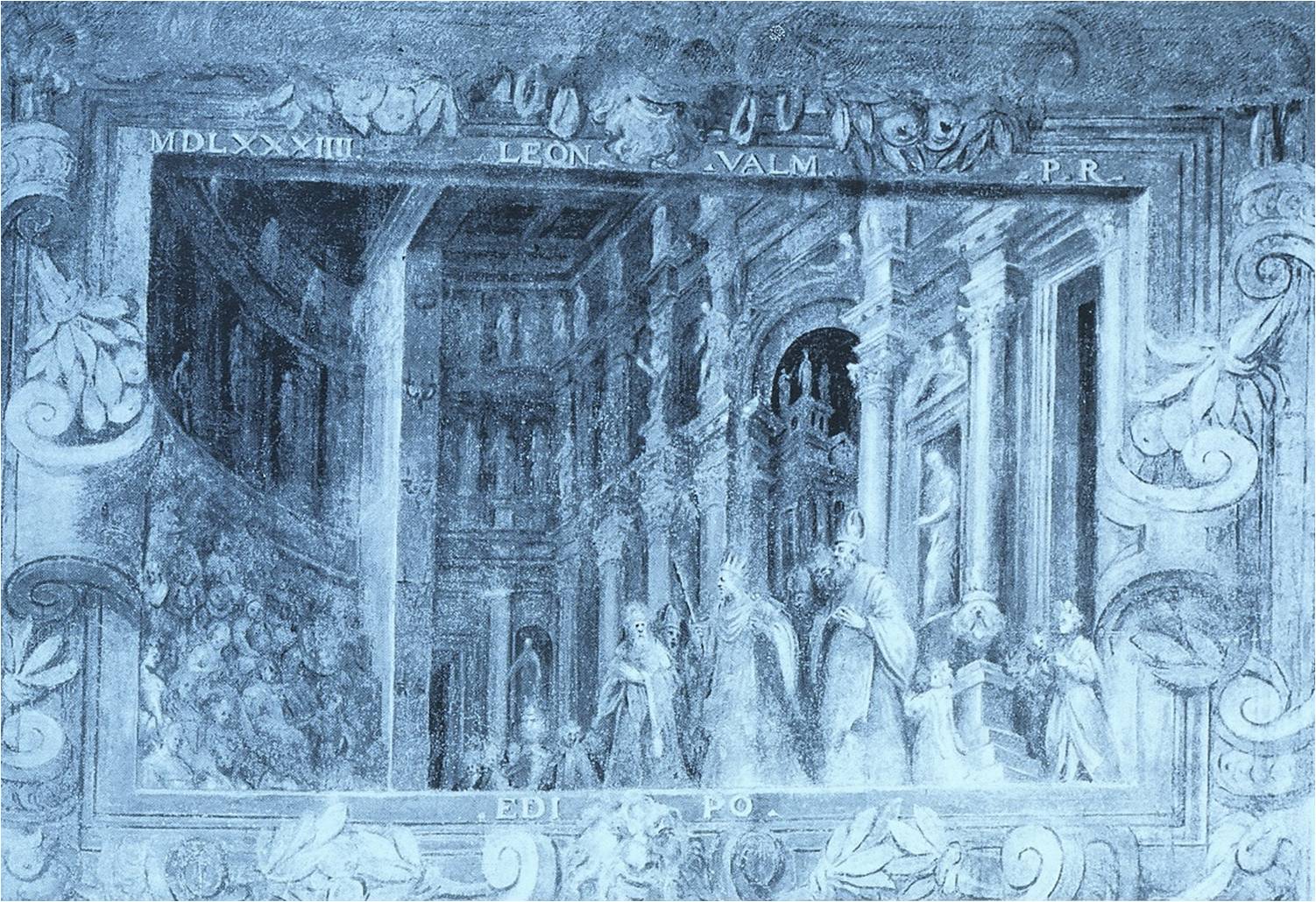
7 | Teatro Olimpico, Vicenza, 1595, Monocromo.
In order to make the scenes more believable [Fig. 7], Ingegneri decided to ascribe a specific connotation to the ancient garments according to their geographical origin. Since the drama was set in Greece, the actors were required to wear a pallium, a typical Hellenic garment, instead of a toga, typically Italic (“la toga in Italia, il pallio in Grecia”) (Gallo 1973, 8; Ingegneri 1598, 71). He believed it to be necessary to opt for the Ancient Greek dress code in the mise-en-scène, avoiding the Roman dress code or any other dress code that could be ascribed to other cultures (“si fugga più che sia possibile l’imitazione del vestir romano e di qual altro si sia abito conosciuto, eccetto il Greco”) (Gallo 1973, 13). Ingegneri was also aware that he could not accomplish a full reconstruction of the clothing worn at the time; therefore, he settled for features that would be easily understood, even if this meant reducing the precision of antiquarian references (“non mi dispiacerà però ancora che egli sia alquanto mescolato con la moderna usanza”) (Gallo 1973, 13). For example, the king’s archers were dressed according to the Turkish style (“Il re con la guardia di 24 arcieri vestiti al costume dei colachi del Gran Turco”) and the king’s crown did not adhere to the ancient diadem form (Gallo 1973, 56).
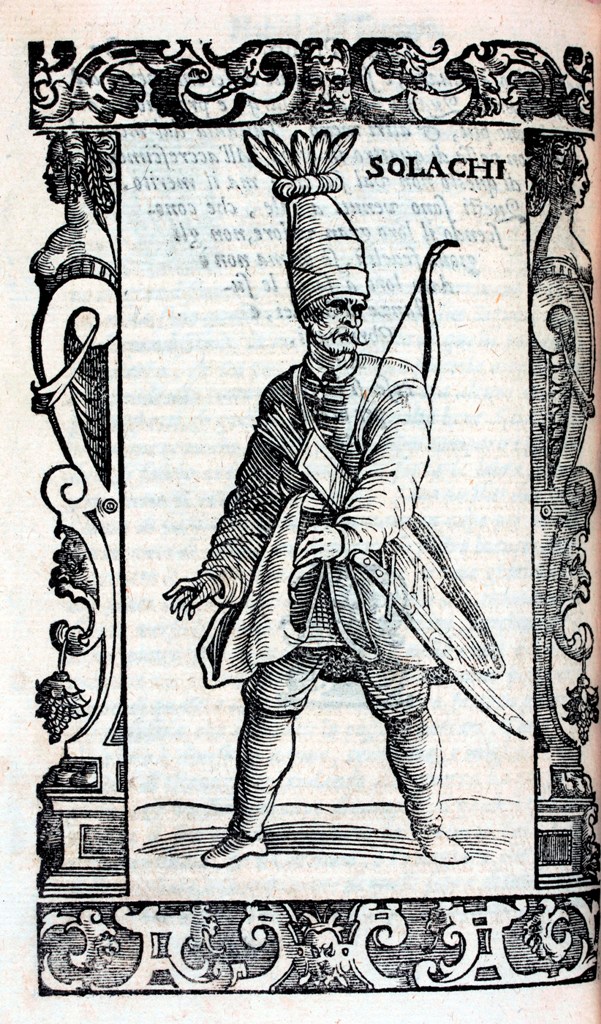
8 | Cesare Vecellio, Delli habiti degli antichi, 1590, p. 387.
In spite of Ingegneri’s directions, the accuracy of the antiquarian model for the mise-en-scène of Edipo tiranno was lacking from the very first performance. This is clear when reading the proposals for the costumes suggested by Speroni, who pressed for higher philological accuracy (Gallo 1973, 54): for example, he discouraged the use of excessively luxurious costumes because the tragedy was set during a period of mourning (“Il suo abito mi par che debba accommodarsi alla tragedia più che alla regal maestà […] onde il re e tutto il popolo era in stato di supplicare e non di pompeggiare”). In another passage, Speroni suggested that missing details in the scenography be reconstructed through the juxtaposition of parallel occurrences: for example, the clothes of Giocasta, the mother (and wife) of Oedipus, could have been aligned with those worn by Penelope, the wife of Ulysses, as described in the Odyssey, who wore a long white dress and a sash on her forehead (“donna attempata, vestita di bianco, la benda avvolta al capo, con due compagne. Così fa Omero Penelope”); or the fortune-teller Tiresias could have been made to conform to a biblical prophet (“Tiresia vestasi quasi alla forma di Aaron nella Bibbia”).
During the performance, the actors’ clothes were very much admired not for their antiquarian accuracy, but for their splendour. Several of the reactions to the play bear testament to this general feeling, although some scholars still disapproved of the unfaithfulness to the original spirit. For example, Riccoboni criticised the character of Tiresias because it contradicted the ancient Greek source, Julius Pollux, who described him as being dressed in rags (“Nel medesimo episodio apparve Tiresia diversamente vestito da quello che scrive Giulio Polluce”) (Gallo 1973, 49); Riccoboni was echoed by Pinelli, who confirmed that this figure was wearing a silk dress, again contrary to the literary source (“Tiresia, contro Polluce, con una sopraveste di seta”) (Gallo 1973, 59).
c)
By comparing these two cases, it is possible to see that theatrical requirements prevailed over antiquarian details, both in terms of the nature of the play and the audience itself (Newton 1975, 19-35). However, a substantial difference seems to appear: in the Roman performance, it was possible to deviate from the historical truth to less annoyance from the spectators; in Vicenza, instead, any variation on a theme was perceived as a negative element, both by the scenographer and by the public.
This shift in perspective is likely to have derived from the evolution of the issue de re vestiaria in antiquarian scholarship. In the first decades of XVI century, when Inghirami was preparing the mise-en-scène of Poenulus, studies on ancient clothing were still too limited to offer a full overview on the matter. By the time Ingegneri prepared his Edipo tyranno, not only from a philological perspective, but also from an iconographic point of view, this topic had been thoroughly investigated and a broader and more complex picture of ancient garments was available to the erudite public. For example, since Turkish archers were described and depicted in many contemporary publications, including the ones by Abraham Bruyn in 1581 and Cesare Vecellio in 1590, they could not be accepted as alternates for the ancients [Fig. 8] (Vecellio 1590, 387).
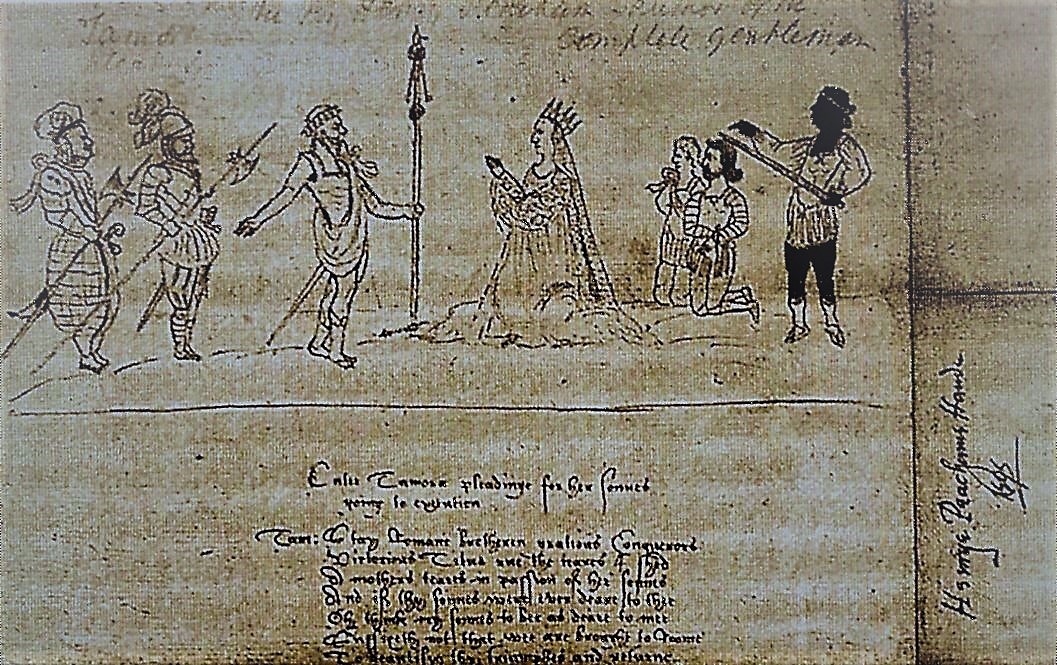
9 | Heinrich Peacham, Titus Andronicus, Longleat ms., 1594.
Conversely, the hypothesis could be advanced that the growth in early modern theatre also influenced the progress of studies on ancient clothing. In this light, each time an edition or a vernacular translation of theatrical texts was published it would have entailed considerations on its ideal performance and, consequently, on the costumes used. On the one hand, it would be interesting to note whether Lazare de Baïf, the father of Renaissance studies on ancient clothing and the translator of Euripides’s Electra (1537) and Hecuba (1544) into French (Baïf 1537b; Baïf 1544), had imagined how they would be presented on stage, including the actors’ costumes, given his experience in this area. On the other hand, it would be interesting to understand if the Peacham drawing (1594) (Berry 1999, 5-6; Levin 2002), an ink sketch at the top of the page of the Longleat manuscript transmitting Shakespeare’s Titus Andronicus [Fig. 9], represents a reliable theatrical scene performed with some kind of erudite inspiration, or just an outline of the clothing totally unrelated to any antiquarian invention.
4. Dressing the ancients (II): the Gallery of Francis I at Fontainebleau
Studies on Roman clothing also had a considerable influence on iconography. A particularly interesting case was the preparation of the pictorial decorations of the Gallery of Francis I in Fontainebleau (Capodieci 2013, 98-106; Primatice 2005; Beguin 1989, 828-838; McAllister Johnson 1972, 153-164), the new residence of the king of France, by the Italian painters Rosso Fiorentino and Primaticcio between 1534 and 1538. An exhaustive iconographic reading was carried out in 1958 by Dora and Erwin Panofsky (Panofsky 1958, 113-90), who proved that the entire cycle of fresco paintings formed a complex encomiastic structure, where each panel presented a precise allegory of episodes from the political and personal life of the king. In recent years, other proposals were added to this opinion (Natali 2006, 225-55; Campbell 2002, 473): Marc Fumaroli, for example, recognised the influence of Luigi Alamanni’s Inni pindarici within the overall structure of the decorations and assumed that the concept behind the entire iconographic programme may have benefitted from the erudite guidance of Lazare de Baïf, conjecturing also that Baïf himself had interceded in bringing Rosso to France (Fumaroli 1996, 102-112).
From this hypothesis, further assumptions can be made. The classical culture of Lazare de Baïf is generally recognized: not only did he study in Italy with Janus Lascaris, enter into correspondence with Pietro Bembo and Erasmus, and collect ancient artworks and findings while he was ambassador to Venice (sent directly by Francis I), but he also brought together a circle of artists and scholars, including the humanist Pietro Aretino, through which he encouraged the circulation and dissemination of ideas (Fumaroli 1996, 105). However, his cultural background cannot be isolated from his antiquarian studies and publications, for which he garnered great fame during the years in which the Fontainebleau frescoes were being completed. In addition to his De re vestiaria of 1526, of which there were at least twelve editions, Baïf published a work entitled De vasculis in 1531, which discussed the receptacles and vases of the ancient world (Baïf 1531), and De re navali, published for the first time in 1536, which dealt with the naval principles known in the ancient world (Baïf 1536). The edition of this last work was dedicated to King Francis I and contained the two previous books in the same volume, creating a practical manual that included all of his antiquarian studies, enriched by an iconographic apparatus perhaps arranged with the drawings of Sebastiano Serlio (Sambin De Norcen 1997, 9-31; Baïf 1537a). As it was the case with ancient clothing, even De vasculis and De re navali were immediately revised by Charles Estienne in 1535 and 1537 respectively (Estienne 1536b; Estienne 1537).
Therefore, if we assume that Baïf participated in the iconographic programme of Fontainebleau, we should focus on finding any influences, coincidences, or real citations of his works in the complex weave of references in the Gallery. On a analysis, no evidence has yet been found to confirm his personal involvement, but his antiquarian knowledge may very well have inspired the development of the programme, even via the medium of Charles Estienne’s revised versions, which would allow for some new general statements to be made, such as the following.
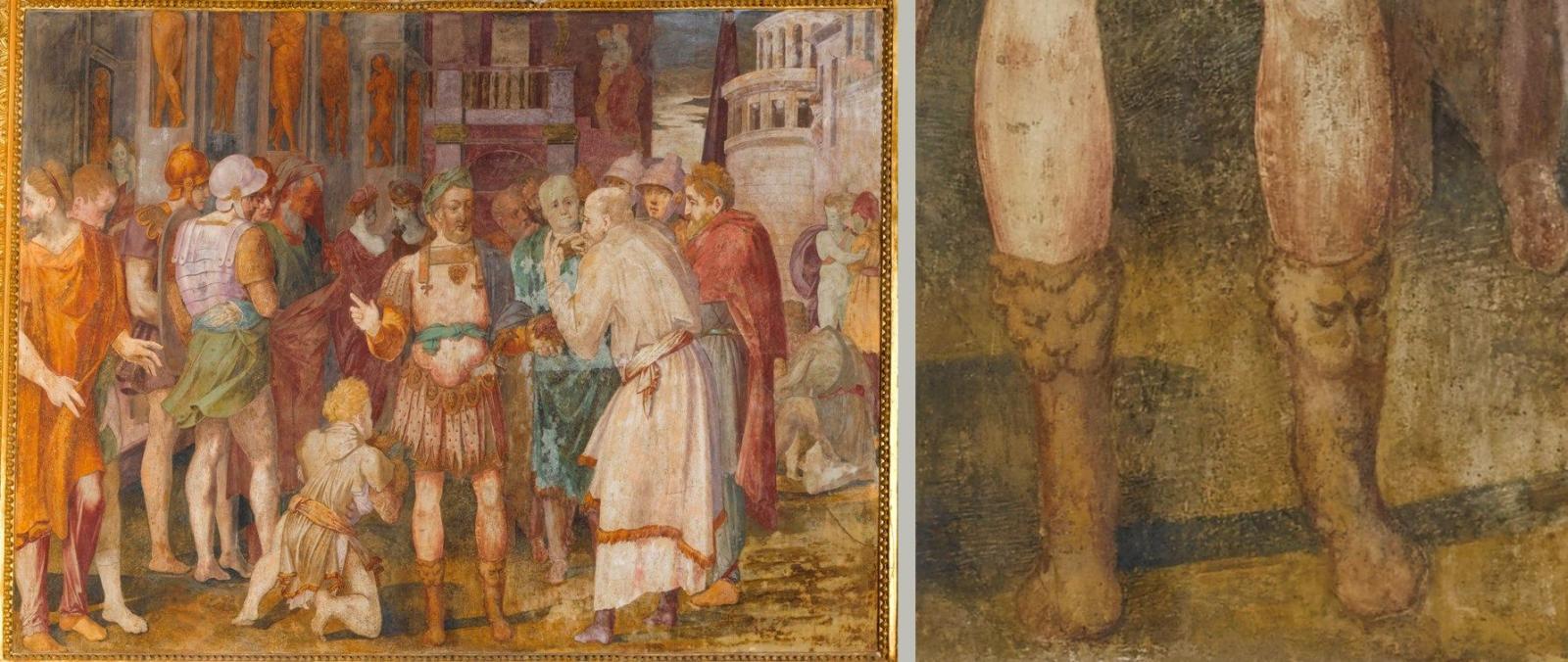
10 | Rosso Fiorentino, The Unity of the State, Fontainebleau, 1534-1538.
11 | Rosso Fiorentino, The Unity of the State, Fontainebleau, 1534-1538, detail.
In the panel entitled The Unity of the State [Fig. 10], some relevant links with both Baïf’s and Estienne’s De re vestiaria treatises can be identified through the central figure, King Francis I, whose clothing recalls antiquarian details, such as the cape over his shoulder (sagum) (Baïf 1526, 48; Estienne 1535a, 25), his leather or linen chest armour (lorica or thorax) (Baïf 1526, 23; Estienne 1535a, 12-3), his long-sleeved tunic (tunica manicata) (Baïf 1526, 40; Estienne 1535a, 21), the belt for his sword (baltheus) (Baïf 1526, 57; Estienne 1535a, 53), his woollen belt (fascia) and his sandals (caligae) adorned with the head of a lion on their upper part [Fig. 11]. However, the last two features coincide only with Estienne’s version: the fascia, in fact, was added in his section on belts (Fasciam autem vulgus vocat, une bande, latum aliquod vinculum, seu laneum, seu lineum fuerit, quo partes aliquae corporis revinciebantur) (Estienne 1535a, 54), and the caligae were described in a chapter devoted to footwear, which was completely ignored in Baïf’s original (atque in extrema parte superiori, cuiusdam animalis ceu leonis caput prae se ferebat) (Estienne 1535a, 15), even though this last feature appears in one of his illustrations in the 1536 edition that was printed under the supervision of Charles Estienne himself (Baïf 1536, 64) [Fig. 12]. Of course, since this last detail features in many ancient statues, as also specified in the caption of the illustration (ex antiquis marmoribus), it could easily have been present in the imagery of the Renaissance artists of the time; however, within this cultural context the strong similarities between the text and the pictorial output cannot be deemed mere coincidence.
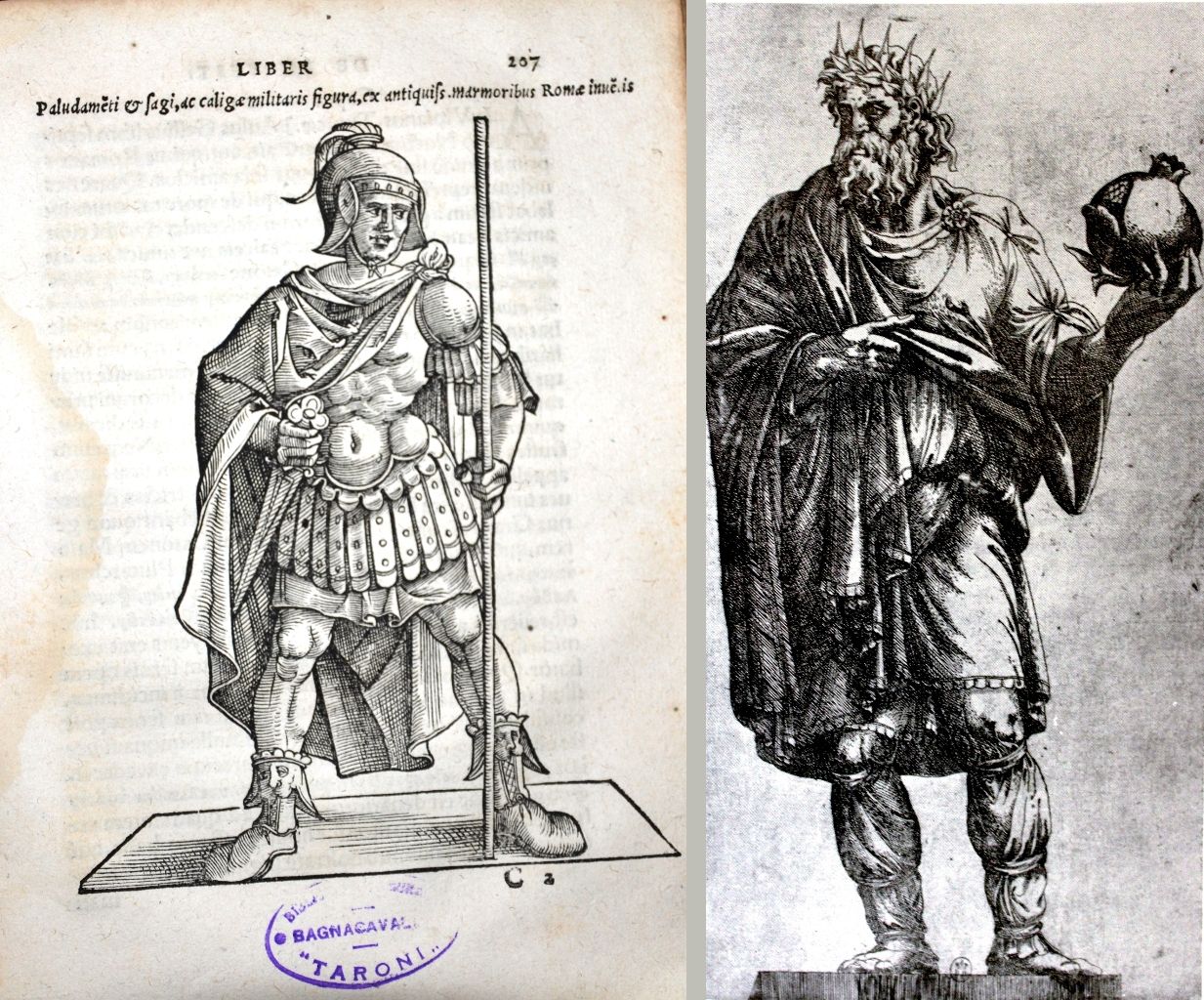
12 | Lazare de Baïf, De re vestiaria, Basel, Froben, 1537, p. 207.
13 | Antonio Fantuzzi, Barbarian king, engraving, 1534-1538.
Another consideration must also be taken into account. In their essay, the Panofskys identified an alternative image to that realised by Rosso Fiorentino in an engraving by Antonio Fantuzzi (Panofsky 1958, 128-30): it was a prototype of the figure of a king with a crown and a pomegranate in his hand, just like the figure featured in the fresco, but in this case credibly recalling Vercingetorix, leader of the Gauls against the Romans [Fig. 13]. This identification was also supported by elements deriving from the clothes worn: in fact, the character wore trousers, a typical Gaulish garment, instead of the Roman tunica or toga. Panofsky attributed this iconography to the famous adage Gallia bracata, reported by Pliny and other ancient sources. There is no intention of questioning the trustworthiness of this identification, but the distinction between Gallia bracata and Gallia togata also appears in Baïf’s and Estienne’s treatises (Baïf 1526, 62, 27; Estienne 1535a, 14, 28), which opens to the possibility that these were taken into consideration during the preparation of the apparatus.
Moreover, always in The Unity of the State, while on the right side of the fresco figures with caped and hooded togas appear, perhaps identifiable with the lacerna (Baïf 1526, 51; Estienne 1535a, 39-40), several characters dressed in Roman clothes can be seen on the left side, including a soldier wearing metal chest armour (thorax plumbeus) (Estienne 1535a, 13), in contrast to the leather armour donned by the king, and a short-sleeved tunic. Such a type of tunic takes on greater significance if the presence of sleeveless tunics is observed, suggesting that this was ascribed meaning by the painters, as can be seen on the right part of the panel titled The Elephant [Fig. 14].
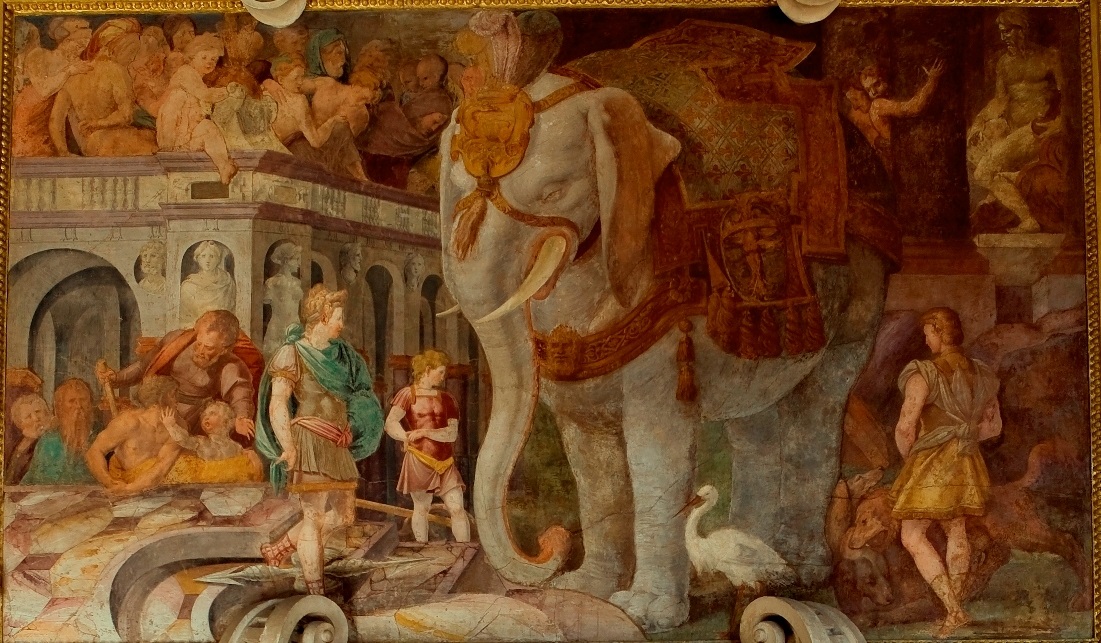
14 | Rosso Fiorentino, The Elephant, Fontainebleau, 1534-1538.
On the left side of the same painting, there is also a figure descending the stairs, wearing clothes similar to those worn by the king in the aforementioned fresco (tunica manicata, sagus, thorax, fascia), but with some differences: for example, the caligae, which are made of intertwined lace, seem very similar to Estienne’s description (caeterum a latere ipsius tibiae fascicola quadam revinciebant atque claudebatur, quam vulgus lassetum appellat: nos etiam corrigiam appellare possumus) (Estienne 1535a, 15).
Furthermore, one should note that the tunic is always the garment worn ‘closest to the body’ by all male figures and serves almost as an equivalent to a modern vest. This peculiarity is also reported in the work of the two French antiquarians (tunica ima) (Baïf 1526, 40; Estienne 1535a, 11), strengthening the link between the information provided in De re vestiaria and the arrangement of this artwork.
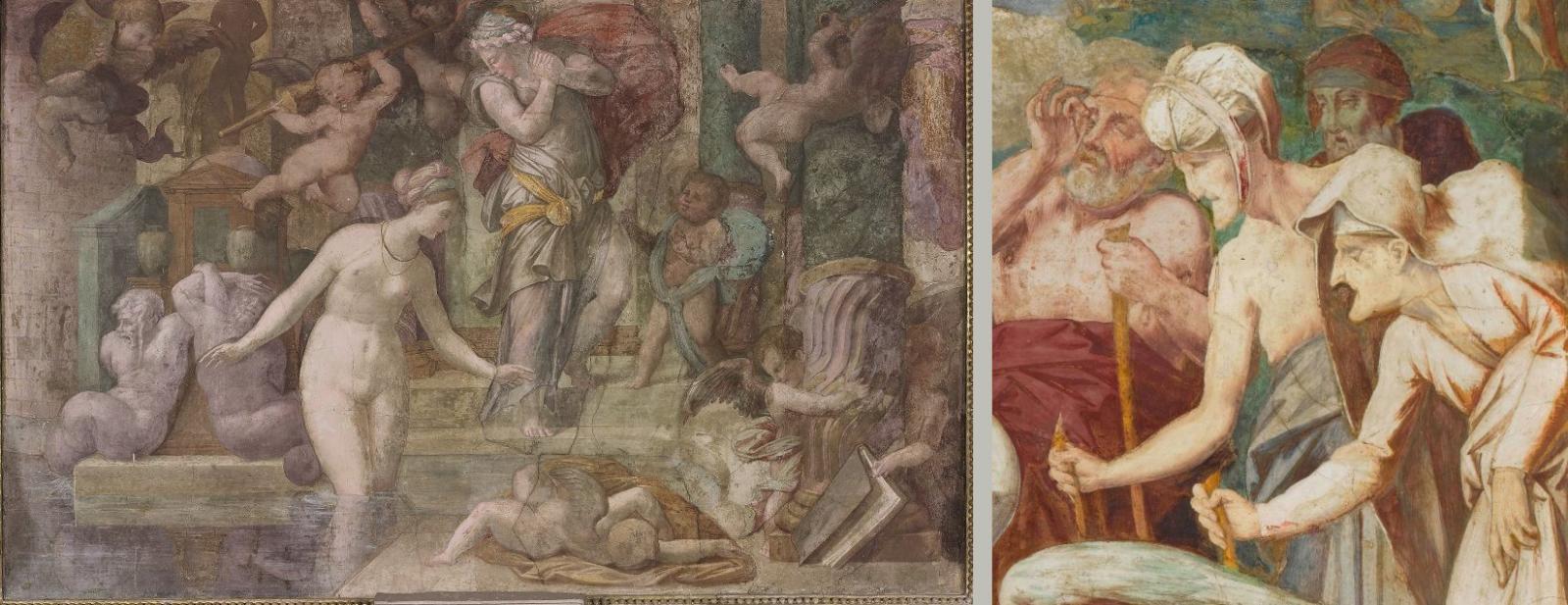
15 | Rosso Fiorentino, The bath of Pallas, Fontainebleau, 1534-1538.
16 | Rosso Fiorentino, Loss of perpetual Youth, Fontainebleau, 1534-1538, detail.
Another garment that reveals this type of erudition is the headdress of women. For example the two female characters in the Bath of Pallas [Fig. 15] have their hair gathered in a bonnet similar to a restis or reticulum (Baïf 1526, 57; Estienne 1535a, 9); moreover, the old mother in the panel Cleobis and Biton [Fig. 16] is perhaps wearing a rica because of the sacrificial setting of the scene (Rica a Romano ritu, quod, ut inquit Varro, Romano ritu sacrificium foeminae cum faciunt, capita velant), just like the female figure with a white headdress is perhaps wearing a vitta (Tegimen capitis matronarum, quo capillos coercebant, et costringebant ac colligebant), in The loss of eternal Youth (Baïf 1526, 57; Estienne 1535a, 10) [Fig. 17].
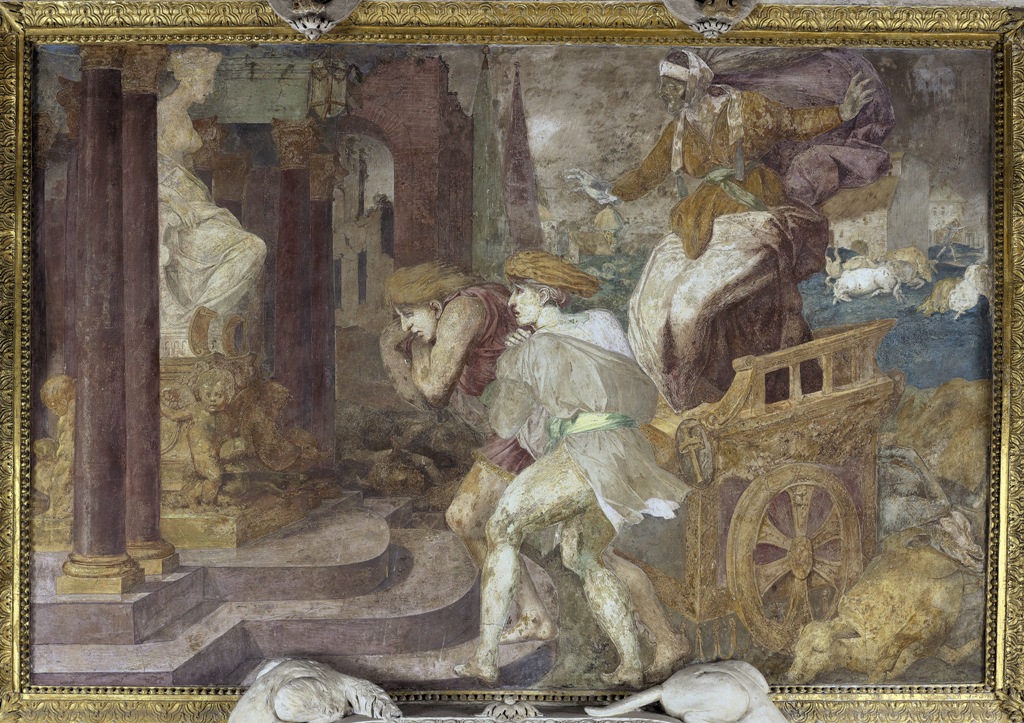
17 | Rosso Fiorentino, Cleobi and Biton, Fontainebleau, 1534-1538, detail.
In addition to these hypotheses on clothing, other elements stemming from the other treatises by Baïf and Estienne on ancient vases and vessels can be found.
In the panel of the Sacrifice [Fig. 18] the vases brought towards the altar could be identified with the various sacrificial ornaments of different forms and materials (Estienne 1535b, 8-23) used also for transporting water (aquaria), wine (vinaria), oil, and various ointments (unguentaria) (Estienne 1535b, 33-46). The poor state of conservation of the paintings and the heavy re-touching carried out in later periods do not aid this analysis to advance any further, however, it is possible to imagine from the few traces of colour left that the first was a crystal vase, the second a golden urceus (Baïf 1531, 57; Estienne 1535b, 40) and the third a silver or lead amphora. The images here do not match perfectly those found in Baïf’s illustrated publications; however, at least general archetypes [Fig. 19] that could link these vases to this work can be found in the pages of Baïf’s 1541 edition of De vasculis.
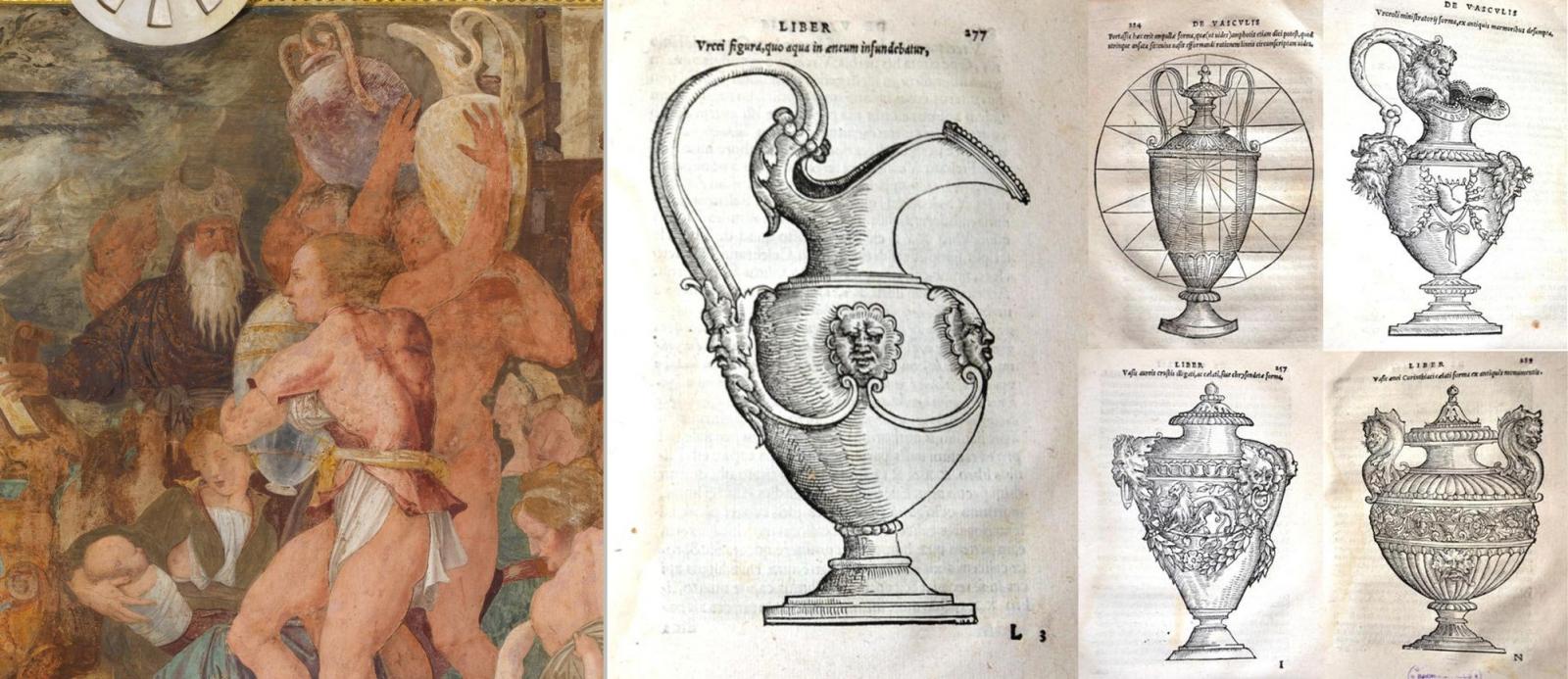
18 | Rosso Fiorentino, Sacrifice, Fontainebleau, 1534-1538, detail.
19 | Lazare de Baïf, De vasculis, Basel, Froben, 1537.
To conclude, a marginal consideration must be made regarding the panel with Nauplius’s Revenge [Fig. 20]. In this fresco depicting an ancient naval battle, a series of vessels appear in a chaotic composition. Even in this case it is possible to find a general link with Baïf’s and Estienne’s De re navali, and some paradigmatic referrals to the nautical universe (Concina 1990): in fact, visual referrals to each part of the ancient ship can be identified in the final tables of these treatises, which could have been easily used in order to increase the philological reliability of the ancient naval imagery (Baïf 1537, 145-8; Estienne 1537, 77-90) [Fig. 21].
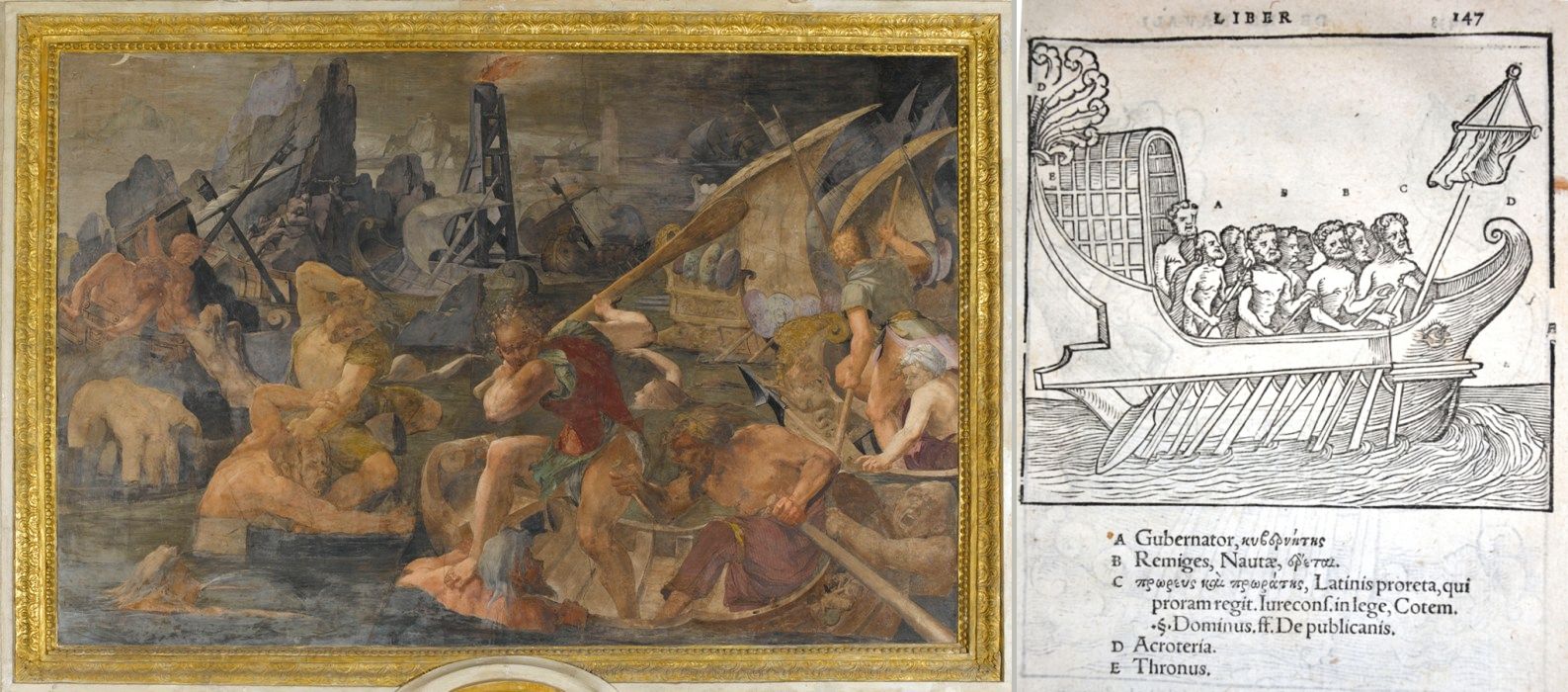
20 | Rosso Fiorentino, Revenge of Nauplius, Fontainebleau, 1534-1538.
21 | Lazare de Baïf, De re navali, Basel, Froben, 1537, p. 147.
Given these assumptions, it could be argued that Lazare de Baïf exerted an influence on the development of the iconographic programme of the Gallery of Francis I at Fontainebleau, and could even have been directly involved. If it is taken as a given that this French scholar was one of the court iconographers, then his antiquarian works must be considered to be intrinsically linked to the images depicted, which would include not only his most famous work De re vestiaria, but also his other works on ancient vessels and vases. It would be more difficult to explain the iconography of the palace if Baïf’s role were excluded from consideration.
Some of the links that emerge from this antiquarian knowledge and these paintings lead to the formulation of a further proposal: the data recorded on ancient clothing, vases, and vessel could well have derived from the works of Charles Estienne rather than directly from those of Baïf. And there are at least two reasons to believe this. First, in addition to all the other coincidences involved, the caligae (both with lions and laces) can be found only in Estienne’s treatise, since Baïf never dealt with the subject of Roman footwear. Second, Estienne’s works were handbooks and therefore easier to consult. They could have been used by the reader to a greater extent than those of Baïf, mainly because of the new structure. Moreover, the presence of a French translation for each Latin term could have aided a more rapid comprehension of the object not only by the young students to whom these treatises were originally addressed, but also by painters and artists.
The assumption could therefore be made that Baïf’s knowledge may have contributed to the development of this iconographic programme, but through the revisions carried out by Estienne between 1535 and 1537 when the Gallery at Fontainebleau was being decorated.
My gratitude goes to Konrad Eisenbichler for showing once again how form and substance belong together.
Bibliography
Primary sources
- Alessandri 1522
A. Alessandri, Genialium dierum libri sex, Roma, 1522. - Baïf 1526
L. Baïf, Annotationum in L. vestis, ff. de auro et argento leg. seu de re vestiaria, liber nunc primum typis excusus, cum indice haudquaquam poenitendo, Basel 1526. - Baïf 1530
L. Baïf, Commentarius de vestium generibus & vocabulis, in L. vestis, ff. de auro & argento, seu re vestiaria. Subiecta est & praefationi lex ipsa, quo faciulius intelligatur, quid in toto libro tractetur. Di Eras. Rot. in ciceroniano, Colon 1530. - Baïf 1531
L. Baïf, Opus de re uestimentaria ab autore ipso diligenter recognitum. Eiusdem, de uasculorum materijs ac uarietate tractatus, antehac nunquam excusus, Basel 1531. - Baïf 1536
L. Baïf, Annotationes in L. 2. de captiuis, et postliminio reuersis. In quibus tractatur de re nauali. Eiusdem annotationes in tractatum De auro & argento leg. quibus, vestimentorum, & vasculorum genera explicantur, Paris 1536. - Baïf 1537a
L. Baïf, Annotationes in legem 2. De captiuis & postliminio reuersis, in quibus tractatur de re nauali, per autorem recognitae. Eiusdem Annotationes in tractatum de auro & argento legato, quibus vestimentorum & vasculorum genera explicantur. His omnibus imagines ab antiquissimis monumentis desumptas ad argumenti declarationem subiunximus. Item Antonii Thylesii De coloribus libellus, à coloribus uestium non alienus, Basel 1537. - Baïf 1537b
L. Baïf, Tragedie de Sophoclés intitulee Electra, Paris 1537. - Baïf 1541
L. Baïf, Annotationes in legem 2. De captiuis & postliminio reuersis, in quibus tractatur de re nauali, per authorem recognitae. Eiusdem annotationes in tractatum De auro & argento legato, quibus vestimentorum & vasculorum genera explicantur. His omnibus, imagines ab antiquissimis monumentis desumptas, ad argumenti declarationem subiunximus. Item Antonii Thylesii De coloribus libellus, a coloribus vestium non alienus, Basel 1541. - Biondo 1559
F. Biondo, De Roma Triumphante, Basel 1559. - Du Choul 1556
G. Du Choul, Discours de la religions des Anciens Romains, Lyon 1556. - Erasmus 1528
D. Erasmus, Adagiorum opus, Basel 1528. - Estienne 1535a
C. Estienne, De re vestiaria libellus, ex Bayfio excerptus; addita vulgaris linguae interpretatione, in adulescentulorum gratiam atque vtilitatem, Paris 1535. - Estienne 1535b
C. Estienne, De vasculis libellus adulescentulorum causa ex Bayfo decerptus, addita vulgari Latinarum vocum interpretatione, Paris 1535. - Estienne 1537
C. Estienne, De re nauali libellus, in adulescentulorum bonarum literarum studiosorum fauorem, ex Bayfij vigilijs excerptus, & in breuem summulam facilitatis gratia redactus, Paris 1537. - Ferrari 1642
O. Ferrari, De re vestiaria libri tres, Padova 1642. - Ferrari 1642
O. Ferrari, De re vestiaria libri septem quatuor postremi nunc primum prodeunt: reliqui emendatiores et auctiores. Adiectis iconibus, quibus res tota oculis subiicitur, Padova 1654. - Ingegneri 1598
A. Ingegneri, Della poesia rappresentativa et del modo di rappresentare le favole sceniche, Ferrara 1598. - Lazius 1551
W. Lazius, Commentariorum reipub. Romanae illius, in exteris prouincijs, bello acquisitis, constitutae, libri duodecim, Basel 1551. - Maffei 1506
R. Maffei, Commentariorum rerum urbanorum liber, Roma 1506. - Manuzio 1576
A. Manuzio, De quaesitis per espistolam libri III, Venezia 1576. - Poliziano 1491
A. Poliziano, Prelectio cui titulus Panepistemon, Firenze 1491. - Ricchieri 1516
L. Ricchieri, Lectionum antiquarum libri, Basel 1516. - Roszfeld 1583
J. Roszfeld, Romanarum antiquitatum libri decem, Basel 1583. - Rubens 1665
A. Rubens, De re vestiaria veterum, Antwerp 1665. - Rubens 1608
P. Rubens, Electorum libri duo, Antwerp 1608. - Sardi 1557
A. Sardi, De moribus et ritibus gentium, libri III, Venezia 1557. - Vecellio 1590
C. Vecellio, De gli habiti antichi, et moderni di diuerse parti del mondo, Venezia 1590. - Virgili 1499
P. Virgili, De inuentoribus rerum libri tres, Venezia 1499.
Secondary sources
- Armstrong 1954
E. Armstrong, Robert Estienne Royal Printer. An historical study of the elder Stefanus, Cambridge, 1954. - Bastianello, Santorio, Torello Hill 2010
E. Bastianello, A. Santoro, G. Torello Hill, Spectacula di Pellegrino Prisciani, “Engramma” 85 (2010). - Beguin 1989
S. Beguin, New evidence for Rosso in France, “The Burlington Magazine” 131 (1989), 828-838. - Berry 1999
H. Berry, The Date on the ‘Peacham’ Manuscript, “Shakespeare Bulletin” 17 (1999), 5–6. - Blanc 1995
O. Blanc, Images du monde et portraits d’habits : les recueils de costumes a la Renaissance, “Bulletin du bibliophile”, 2 (1995), 221-261. - Butazzi 1995
G. Butazzi, Repertori di costumi e stampe di moda tra i secoli XVI e XVIII, in R. Varese, G. Butazzi (eds.), Storia della moda, Bologna 1995, 1-25. - Campbell 2002
T. P. Campbell, Tapestry in the Renaissance: art and magnificence, New York 2002 - Capodieci 2013
L. Capodieci, L’univers imaginaire de Rosso dans la galerie François I, in V. Droguet, T. Cré pin-Leblond (eds.) Le roi et l’artiste. Fronçois I et Rosso Fiorentino, Paris 2013. - Cooper 2013
R. Cooper, Roman Antiquities in Renaissance France, 1515-1565, Farnham 2013. - Concina 1990
E. Concina, Navis. L'umanesimo sul mare, Torino 1990. - Cruciani 1968
F. Cruciani, Il teatro del Campidoglio e le feste romane del 1513, Milano 1968. - Davanzo Poli 2004
D. Davanzo Poli, De los libros de los sastres a los repertorios de moda del siglo XVI, in R. de la Puerta, D. Davanzo Poli, P. Venturelli, Il libro del sarto. Estudio de las miniaturas, Valencia 2004, 41-51. - DBI 2004
Tommaso Inghirami detto Fedra, in Dizionario Biografico degli Italiani, vol. 62, Roma 2004. - DBI 2005
Pirro Ligorio, in Dizionario Biografico degli Italiani, vol. 65, Roma 2005. - De la Garanderie 1985
M. M. De la Garanderie, ‘Lazare de Baïf’, in Contemporaries of Erasmus: a biographical register of the Renaissance and Reformation, Toronto 1985. - Fumaroli 1996
M. Fumaroli, Rosso tra Italia e Francia, in R. P. Ciardi, A. Natali (eds.) Pontormo e Rosso, Atti del convegno di Empoli e Volterra, Venezia 1996. - Gallo 1973
A. F. Gallo, La prima rappresentazione al Teatro Olimpico: con i progetti e le relazioni dei contemporanei, Milano 1973. - Gualdo Rosa 2009
L. Gualdo Rosa, Raffaele Maffei, in Repertorium Pomponianum, 2009. www.repertoriumpomponianum.it/pomponiani/maffei_raffaele_volterrano.htm (visited on 24/3/2017) - Guérin Dalle Mese 1998
J. Guérin Dalle Mese, L’occhio di Cesare Vecellio. Abiti e costumi esotici nel Cinquecento, Alessandria 1998. - Jones, Stallybrass 2000
A. R. Jones, P. Stallybrass, Renaissance clothing and the materials of memory, Cambridge 2000. - Leblanc 1972
P. Leblanc, Les écrits théoriques et critiques français des années 1540-1561 sur la tragédie, Paris 1972. - Levin 2002
R. Levin, The Longleat Manuscript and Titus Andronicus, “Shakespeare Quarterly”, 53.3 (2002), 323-340. - Luzi 1887
A. Luzi, Federico Gonzaga ostaggio alla corte di Giulio II, “Archivio della Regia Società di Storia Patria” IX (1887). - Mason Rinaldi 1981
S. Mason Rinaldi, Da Veronese a Palladio: studi di costume per l’Edipo Tiranno, in M. Di Giampaolo (ed.), Per A. E. Popham, Parma 1981. - Mazzoni 2010
S. Mazzoni, L’Olimpico di Vicenza: un teatro e la sua “perpetua memoria”, Florence, 2010. - Mazzoni 2013
S. Mazzoni, 'Edipo tiranno' all'Olimpico di Vicenza (1585)’, in “Dionysius ex Machina”, 4 (2013), 280-301. - McAllister Johnson 1972
W. McAllister Johnson, Le programme. B/ Le programme monarchique, in La Galerie François I au château de Fontainebleau, “Revue de l’art”, special issue 16-17 (1972), 153-164. - Natali 2006
A. Natali, Rosso Fiorentino: leggiadra maniera e terribilità di cose stravaganti, Cinisello Balsamo 2006. - Nevinson 1952
J. J. Nevinson, L’origine de la gravures de mode, in Actes du I Congres International d’histoire du Costume, Venezia 1952, 202-212. - Newton 1975
M.S. Newton, Renaissance theatre costume, London 1975. - Nolhac 1883
P. de Nolhac, Lettres inédites de Paul Manuce, in “Mélanges d'archéologie et d'histoire”, 3 (1883), 267-289. - Nolhac 1894
P. de Nolhac, Pietro Bembo et Lazare de Baïf, in Nozze Cian-Sappa Flandinet, Bergamo 1894. - Panofsky 1958
E. Panofsky, D. Panofsky, The Iconography of the Galerie François Ier at Fontainebleau, “Gazette des Beaux-Arts”, 52 (1958), 113-90. - Pinvert 1900
L. Pinvert, Lazare de Baïf: 1496 (?)-1547, Paris, 1900. - Primatice 2005
Primatice: maître de Fontainebleau, Paris 2004. - Puppi 1987
L. Puppi, I costumi per la recita inaugurale del teatro Olimpico a Vicenza (e altre questioni), “Storia dell’Arte”, 61 (1987), 189-200. - Reolon 2013
G. Reolon, I costumi degli antichi romani negli Habiti di Cesare Vecellio, “Engramma” 112 (2013), 58-123. - Rosenthal, Jones 2010
M. Rosenthal, A. R. Jones (a cura di), Cesare Vecellio, Habiti antichi et moderni. La moda nel Rinascimento: Europa, Asia, Africa, Americhe, Roma 2010. - Sambin De Norcen 1997
M. T. Sambin De Norcen, Studio dell’antico e insegnamento d’architettura nella Venezia del Primo Cinquecento, “Saggi e Memorie di Storia dell'Arte”, 21 (1997), 9-31. - Schrade 1960
L. Schrade, La représentation d’Edipo Tiranno au Teatro Olimpico (Vicence 1585), Paris 1960. - Scott, Sturm-Maddox 2007
V. Scott, S. Storum-Maddox, Performance, poetry and politics on the Queenʻs day: Catherine de Médicis and Pierre de Ronsard at Fontainbleau, Aldershot 2007. - van der Meulen 1994
M. van der Meulen, Rubens: copies after the antique, London 1994. - Vout 1996
C. Vout, The Myth of the Toga: Understanding the History of Roman Dress, “Greece & Rome”, 43.2 (1996), 204-220. - Vout 2010
C. Vout, Toga, in A. Grafton, G. Most, S. Settis (eds.), The Classical Tradition, Cambridge (Mass) 2010, 937-938. - Zilli 1991
L. Zilli, Mellin de Saint-Gelais, Jacques Amyot e un manoscritto della tragedia Sophonisba, “Studi di Letteratura Francese” 17 (1991), 7-29. - Zorzi 1971
L. Zorzi, Elementi per la visualizzazione della scena venata prima di Palladio, in M.T. Muraro (ed.) Studi sul teatro venero fra Rinascimento e Barocco, Firenze 1971.
Bi
English abstract
This article explores the development of scholarly discourse on ancient clothing during the Renaissance, tracing its origins, evolution, and influences on cultural and artistic endeavors. While conventional narratives attribute the emergence of interest in ancient garments to seventeenth-century Italian and Flemish scholars, the author contends that this fascination began approximately 150 years earlier. Examining works by early modern scholars such as Ottavio Ferrari, Albert Rubens, Cesare Vecellio, and Lazare de Baïf, the article reveals a complex and stratified cultural tradition that incorporated literary and material sources.
The analysis distinguishes two primary approaches adopted by Renaissance scholars: one focusing on literary sources to understand garment forms and functions, and the other relying on material sources like archaeological findings. The convergence of these approaches allowed scholars to assign names and shapes to ancient garments, despite the challenges posed by evolving customs and unclear representations in artifacts. The article identifies key treatises on ancient clothing during the Renaissance, categorizes them into three phases, and highlights the methodological shifts that occurred.
keywords: ancient clothing, Reinassance, De re vestiaria.
Per citare questo articolo / To cite this article: D. Acciarino, De re vestiaria. Renaissance discovery of ancient clothing, “La Rivista di Engramma” n. 154, marzo 2018, pp. 119-151 | PDF
